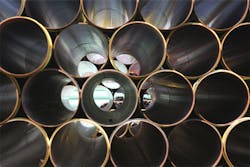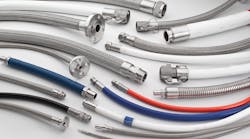Donald Townley, P.E., is a piping system specialist for Corzan Industrial Piping Systems, a subsidiary of Noveon Inc. He earned a bachelor’s degree in Mechanical Engineering from the University of Cincinnati and is a licensed professional engineer. Mr. Townley has been active in code development activities, presenting numerous code changes to both the UPC and IPC. He is a former member of the NFPA Technical Committee on Residential Sprinkler Systems and the IAPMO Standards, Uniform Mechanical, and Uniform Plumbing code committees. Mr. Townley can be reached at [email protected] or 888 234-2436, ext. 5244.
Q: Respectively, what are the key application advantages/disadvantages of nonmetallic, metallic and nonmetallic-lined metallic pipe?
A: It’s important to note that all piping materials have inherent strengths and weaknesses. As such, no one material is ideal for all applications.
Metal has been used longer than any other material in piping applications. On the positive side, metal offers higher pressure bearing capabilities than alternative materials. In addition, it is not temperature sensitive, which is to say that its pressure bearing capabilities are not reduced by increases in temperature. And with metal, hangers can be spaced farther apart to save on installation costs and labor.
The most serious disadvantage of metal is interior and exterior corrosion. Aggressive fluids inside the pipe may cause it to corrode from within, while elements such as salt in the air can cause external corrosion. Metal is also subject to scale buildup, which restricts flow.
In addition, it is more expensive to install, both from a material cost and labor perspective. A cost analysis prepared by the Plastics Pipe and Fittings Association in 2003 estimated 100 feet of six-inch carbon steel pipe cost $22,789 vs. $18,932 for the same length of CPVC pipe.
Nonmetallic offers lower material costs than metal, and its labor costs are also significantly lower due to a fast, easy solvent cement joining system. From a long-term performance perspective, CPVC is 100 percent immune to both interior and exterior corrosion in most recommended applications. It offers strong insulating advantages, which increase energy efficiency, minimize condensation, and make it safe to touch, regardless of the temperature of the liquid being transported. It is also lighter in weight, which makes it easier to maneuver on the job site.
On the negative side, CPVC has lower pressure bearing capabilities, which are dependent on fluid temperature. During installation, CPVC pipe also requires more hangers to support the pipe. This can be a problem in areas where there is insufficient space for additional hangers.
Nonmetallic-lined metallic pipe combines the advantages of metal and CPVC, while minimizing many of the disadvantages of both pipe materials. It is immune to internal corrosion (although still subject to external corrosion); scale buildup concerns are eliminated; and the pipe has the same superior pressure bearing capabilities as metal.
A major disadvantage is cost. Nonmetallic-lined pipe is by far the most expensive piping material of the three being evaluated in this article. In addition, it requires a difficult, labor-intensive joining process. Finally, if a break in the lining occurs, it can become a major source for future pipe failure.
Q: What are the most important elements of an effective piping design strategy?
A: Most critical to a successful piping systems design strategy is to choose a material that best suits the application. Many design elements should be considered before making a final choice, including: the type of fluid being handled; the various temperatures and pressures at which the system will be operating; the desired service life of the system; economics (short-term and long-term); product availability of the pipe, valve and fitting sizes; external factors such as exposure to UV light, corrosive soil, or atmospheric conditions, etc.; and the ease of system maintenance.
Q: What are some of the key standards for piping systems design? How important are these standards in an overal systems design strategy?
A: Although there are ASTM standards that provide general installation guidance, it’s more important for designers to review the specific manufacturer’s installation guidelines. This is especially true when using a nonmetallic material. Metal has been used for many years, so most designers are already familiar with potential challenges. But the newer, more specialized materials, like CPVC, have different instructions and guidelines. If it’s your first time using a nonmetallic material, you need to become thoroughly familiar with its unique attributes and uses.
Keep in mind, too, that not all CPVC is the same. Manufacturers use different base resins, which can affect material performance significantly. Some companies also offer more technical support and chemical resistance data to help designers through unusual situations or challenges. This level of support and information should be taken into consideration when choosing a material manufacturer.
Q: What one piece of advice would you offer to piping systems designers?
A: More than anything, it’s important to keep an open mind and consider all the options before making a decision about piping material. Don’t be afraid to investigate new materials. Evaluate all alternatives for their individual strengths and weaknesses. Do your homework to determine what’s best for a particular application. There are a number of resources to help familiarize users with the newer, nonmetallic options. Two resources to consider are the Plastic, Pipe and Fittings Association and the Plastic Pipe Institute..


